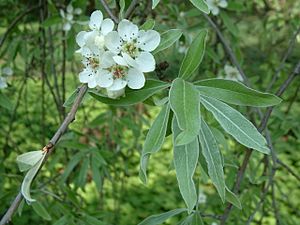Pyrus salicifolia facts for kids
Quick facts for kids Pyrus salicifolia |
|
|---|---|
 |
|
| Conservation status | |
| Scientific classification | |
| Genus: |
Pyrus
|
| Species: |
salicifolia
|
The willow-leaved pear (scientific name: Pyrus salicifolia) is a special type of pear tree. It comes from the Middle East. People often grow it as a beautiful garden tree. It's usually a "weeping" tree, meaning its branches hang down, just like a weeping willow.
This tree is quite small, usually growing to about 10 to 12 meters (33 to 39 feet) tall. It loses its leaves in the fall, so it's a deciduous tree. Its leaves are silvery and look a bit like willow leaves. The flowers are big and pure white, with black tips on their stamens (the parts that hold pollen). Even the flower buds have red tips! The tree also grows small green fruits, but you can't eat them because they are hard and taste bitter.
Growing Willow-Leaved Pear Trees
This tree is very popular in gardens and parks. It can grow well even in sandy soil that isn't very rich in nutrients. This is because its roots spread out widely.
The willow-leaved pear flowers in the spring. For the rest of the year, you can trim and shape it. You can even make it look like topiary, which means shaping plants into fun designs.
However, these trees can get a sickness called fireblight. This is a bacterial disease that can harm the tree.
How to Tell It Apart
Sometimes, people might confuse the willow-leaved pear with other similar trees.
- Pyrus nivalis is usually taller and doesn't have the same weeping branches.
- Pyrus elaeagnifolia has wider leaves that are not divided, and longer leaf stems.
Awards and Recognition
A special type of willow-leaved pear, called 'Pendula', has won an important award. It received the Royal Horticultural Society's Award of Garden Merit. This award means it's a great plant for gardens.
 In Spanish: Peral de hojas de sauce para niños
In Spanish: Peral de hojas de sauce para niños


